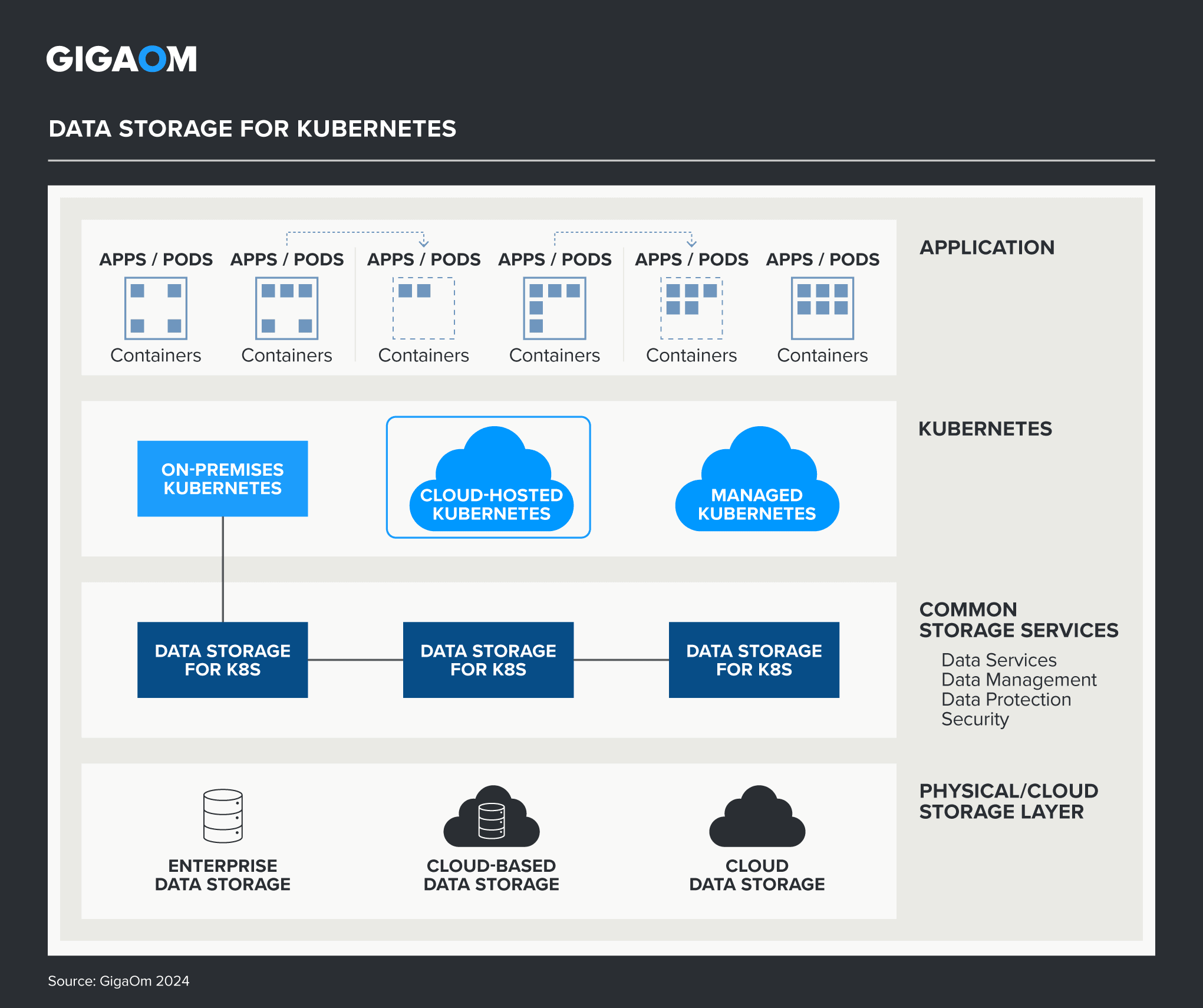Table of Contents
- Executive Summary
- Kubernetes Data Storage Sector Brief
- Decision Criteria Analysis
- Analyst’s Outlook
- Methodology
- About Joep Piscaer
- About GigaOm
- Copyright
1. Executive Summary
Kubernetes, the cloud-native data storage container orchestration system, is now ubiquitous—across the major hyperscale and edge cloud providers, smaller independent service providers, and on-premises data centers. The Kubernetes API and associated storage protocols are no longer emerging or optional open-source technology; they are a hard requirement for organizations looking to develop and deploy applications.
With its widespread adoption across cloud, edge, and on-premises infrastructure, Kubernetes is instrumental in executing the vision of portable, flexible, and agile hybrid cloud strategies, making applications and their data both portable and cloud-agnostic—for the most part. It still needs the right integration with infrastructure layers, such as storage, to complement its still maturing native support for stateful data storage.
While organizations have discovered the ease of operation that the ubiquitous availability of Kubernetes APIs brings, they have also learned that infrastructure dependencies like storage are still a major consideration for full-blown production deployments with mission-critical applications, especially in multicloud scenarios. The architecture of the control plane and specific scenarios of how and where it can be deployed are determining factors in how well a storage platform can be integrated into these infrastructure environments.
It’s still a significant task to select and implement a Kubernetes storage solution for persistent data that makes the most of its application mobility and data portability potential. Spurred by the rising popularity of cloud computing and containerized applications, developers are increasingly discovering the value and operational simplicity of integrating storage capabilities into Kubernetes seamlessly. However, in some cases, the storage solution you already have for other workloads is the best storage solution to get started with for Kubernetes.
This report discusses storage solutions that have a native integration into Kubernetes through the container storage interface (CSI) and other means. GigaOm recognizes the various storage architectures and breadth of storage usage across various runtime platforms, including cloud-based virtualization, on-premises virtualization (VMware, KubeVirt, and others), and bare metal, and it recognizes that many organizations do not buy storage solutions specifically for their Kubernetes estate but rather reuse existing storage solutions that continue to also serve non-Kubernetes platforms simultaneously, leading to a complex landscape of how and where storage is used. Hence, in this report, we cover both more traditional enterprise storage array solutions that support Kubernetes and more Kubernetes-native solutions that are co-located on the Kubernetes cluster nodes in hyperconverged architectures. For each solution, we’ll note which deployment model is involved.
Business Imperative
As storage vendors continue to work on adding native Kubernetes support, finding the right solution to fit your requirements remains a non-trivial task. This is a challenge because vendors must support a common data storage layer that abstracts physical and cloud resources with a standard set of features and services for data protection, security, and enterprise data management (as shown in Figure 1).
Figure 1. Data Storage for Kubernetes
With Kubernetes now supporting business-critical applications and services, requirements become more stringent. Scalability, performance, resilience, security, and other nonfunctional requirements are the order of the day, and Kubernetes must do it all to ensure a consistent level of throughput without service disruptions. These requirements drive the demand for enterprise-class stateful data services, solid security controls, mature multitenant performance management—like quality of service (QoS) and bandwidth throttling—and thorough alerting, reporting, and monitoring.
Lastly, enterprises do not want to be locked into any single vendor’s ecosystem as they reap the benefits of Kubernetes’ portable and agnostic promise, and they look for a storage solution that works with feature parity across on-premises and cloud infrastructures, requiring flexibility on the solution’s part as it’s deployed across various cloud and on-premises environments.
Sector Adoption Score
To help executives and decision-makers assess the potential impact and value of a Kubernetes storage solution deployment to the business, this GigaOm Key Criteria report provides a structured assessment of the sector across five factors: benefit, maturity, urgency, impact, and effort. By scoring each factor based on how strongly it compels or deters adoption of a Kubernetes storage solution, we provide an overall Sector Adoption Score (Figure 2) of 4.6 out of 5, with 5 indicating the strongest possible recommendation to adopt. This indicates that a Kubernetes storage solution is a very credible candidate for deployment and worthy of thoughtful consideration.
The factors contributing to the Sector Adoption Score for Kubernetes storage are explained in more detail in the Sector Brief section that follows.
Key Criteria for Evaluating Kubernetes Data Storage Solutions
Sector Adoption Score
Figure 2. Sector Adoption Score for Kubernetes Storage
This is the fifth year that GigaOm has reported on the Kubernetes storage space in the context of our Key Criteria and Radar reports. This report builds on our previous analysis and considers how the market has evolved over the last year. As the market evolves and consolidates, we are combining the two separate reports (enterprise Kubernetes storage and cloud-native Kubernetes storage) of earlier editions into a single report.
This GigaOm Key Criteria report highlights the capabilities (table stakes, key features, and emerging features) and nonfunctional requirements (business criteria) for selecting an effective Kubernetes data storage solution. The companion GigaOm Radar report identifies vendors and products that excel in those decision criteria. Together, these reports provide an overview of the market, identify leading Kubernetes data storage offerings, and help decision-makers evaluate these solutions so they can make a more informed investment decision.
GIGAOM KEY CRITERIA AND RADAR REPORTS
The GigaOm Key Criteria report provides a detailed decision framework for IT and executive leadership assessing enterprise technologies. Each report defines relevant functional and nonfunctional aspects of solutions in a sector. The Key Criteria report informs the GigaOm Radar report, which provides a forward-looking assessment of vendor solutions in the sector.
